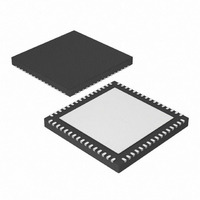DSPIC33FJ64GS606-I/MR Microchip Technology, DSPIC33FJ64GS606-I/MR Datasheet - Page 100

DSPIC33FJ64GS606-I/MR
Manufacturer Part Number
DSPIC33FJ64GS606-I/MR
Description
IC MCU/DSP 64KB FLASH 64QFN
Manufacturer
Microchip Technology
Series
dsPIC™ 33Fr
Specifications of DSPIC33FJ64GS606-I/MR
Program Memory Type
FLASH
Program Memory Size
64KB (64K x 8)
Package / Case
64-VFQFN, Exposed Pad
Core Processor
dsPIC
Core Size
16-Bit
Speed
40 MIPs
Connectivity
CAN, I²C, IrDA, LIN, SPI, UART/USART, USB
Peripherals
Brown-out Detect/Reset, DMA, QEI, POR, PWM, WDT
Number Of I /o
58
Ram Size
9K x 8
Voltage - Supply (vcc/vdd)
3 V ~ 3.6 V
Data Converters
A/D 16x10b; D/A 1x10b
Oscillator Type
Internal
Operating Temperature
-40°C ~ 85°C
Product
DSCs
Data Bus Width
16 bit
Processor Series
DSPIC33F
Core
dsPIC
Numeric And Arithmetic Format
Fixed-Point or Floating-Point
Instruction Set Architecture
Harvard
Device Million Instructions Per Second
40 MIPs
Maximum Clock Frequency
120 MHz
Number Of Programmable I/os
58
Data Ram Size
4 KB
Operating Supply Voltage
3.3 V
Maximum Operating Temperature
+ 85 C
Mounting Style
SMD/SMT
3rd Party Development Tools
52713-733, 52714-737, 53276-922, EWDSPIC
Development Tools By Supplier
PG164130, DV164035, DV244005, DV164005, PG164120, DM240001, DV164033
Interface Type
I2C, SPI, UART
Minimum Operating Temperature
- 40 C
On-chip Adc
10 bit, 16 Channel
On-chip Dac
10 bit, 4 Channel
Lead Free Status / RoHS Status
Lead free / RoHS Compliant
Eeprom Size
-
Lead Free Status / Rohs Status
Lead free / RoHS Compliant
Available stocks
Company
Part Number
Manufacturer
Quantity
Price
Company:
Part Number:
DSPIC33FJ64GS606-I/MR
Manufacturer:
Microchip
Quantity:
176
- Current page: 100 of 418
- Download datasheet (3Mb)
dsPIC33FJ32GS406/606/608/610 and dsPIC33FJ64GS406/606/608/610
4.2.7
In addition to its use as a working register, the W15
register in the dsPIC33FJ32GS406/606/608/610 and
dsPIC33FJ64GS406/606/608/610 devices is also used
as a software Stack Pointer. The Stack Pointer always
points to the first available free word and grows from
lower to higher addresses. It predecrements for stack
pops and post-increments for stack pushes, as shown
in Figure 4-6. For a PC push during any CALL instruc-
tion, the MSb of the PC is zero-extended before the
push, ensuring that the MSb is always clear.
The Stack Pointer Limit register (SPLIM) associated
with the Stack Pointer sets an upper address boundary
for the stack. SPLIM is uninitialized at Reset. As is the
case for the Stack Pointer, SPLIM<0> is forced to ‘0’
because all stack operations must be word-aligned.
Whenever an EA is generated using W15 as a source
or destination pointer, the resulting address is
compared with the value in SPLIM. If the contents of
the Stack Pointer (W15) and the SPLIM register are
equal and a push operation is performed, a stack error
trap will not occur. The stack error trap will occur on a
subsequent push operation. For example, to cause a
stack error trap when the stack grows beyond address
0x1800 in RAM, initialize the SPLIM with the value
0x17FE.
Similarly, a Stack Pointer underflow (stack error) trap is
generated when the Stack Pointer address is found to
be less than 0x0800. This prevents the stack from
interfering with the Special Function Register (SFR)
space.
A write to the SPLIM register should not be immediately
followed by an indirect read operation using W15.
FIGURE 4-6:
DS70591C-page 100
0x0000
Note:
15
000000000
SOFTWARE STACK
A PC push during exception processing
concatenates the SRL register to the MSb
of the PC prior to the push.
<Free Word>
PC<15:0>
PC<22:16>
CALL STACK FRAME
0
POP : [--W15]
PUSH : [W15++]
W15 (before CALL)
W15 (after CALL)
Preliminary
4.3
The addressing modes shown in Table 4-65 form the
basis of the addressing modes optimized to support the
specific features of individual instructions. The
addressing modes provided in the MAC class of
instructions differ from those in the other instruction
types.
4.3.1
Most file register instructions use a 13-bit address field
(f) to directly address data present in the first 8192
bytes of data memory (near data space). Most file
register instructions employ a working register, W0,
which is denoted as WREG in these instructions. The
destination is typically either the same file register or
WREG (with the exception of the MUL instruction),
which writes the result to a register or register pair. The
MOV instruction allows additional flexibility and can
access the entire data space.
4.3.2
The three-operand MCU instructions are of the form:
Operand 3 = Operand 1 <function> Operand 2
where Operand 1 is always a working register (that is,
the addressing mode can only be register direct), which
is referred to as Wb. Operand 2 can be a W register,
fetched from data memory, or a 5-bit literal. The result
location can be either a W register or a data memory
location.
supported by MCU instructions:
• Register Direct
• Register Indirect
• Register Indirect Post-Modified
• Register Indirect Pre-Modified
• 5-bit or 10-bit Literal
Note:
Instruction Addressing Modes
The
FILE REGISTER INSTRUCTIONS
MCU INSTRUCTIONS
Not all instructions support all the
addressing modes given above. Individual
instructions can support different subsets
of these addressing modes.
following
2010 Microchip Technology Inc.
addressing
modes
are
Related parts for DSPIC33FJ64GS606-I/MR
Image
Part Number
Description
Manufacturer
Datasheet
Request
R

Part Number:
Description:
IC, DSC, 16BIT, 12KB, 40MHZ, 3.6V, DIP28
Manufacturer:
Microchip Technology
Datasheet:

Part Number:
Description:
Manufacturer:
Microchip Technology Inc.
Datasheet:

Part Number:
Description:
Manufacturer:
Microchip Technology Inc.
Datasheet:

Part Number:
Description:
Manufacturer:
Microchip Technology Inc.
Datasheet:

Part Number:
Description:
Manufacturer:
Microchip Technology Inc.
Datasheet:

Part Number:
Description:
Manufacturer:
Microchip Technology Inc.
Datasheet:

Part Number:
Description:
Manufacturer:
Microchip Technology Inc.
Datasheet:

Part Number:
Description:
Manufacturer:
Microchip Technology Inc.
Datasheet:

Part Number:
Description:
Manufacturer:
Microchip Technology Inc.
Datasheet:











